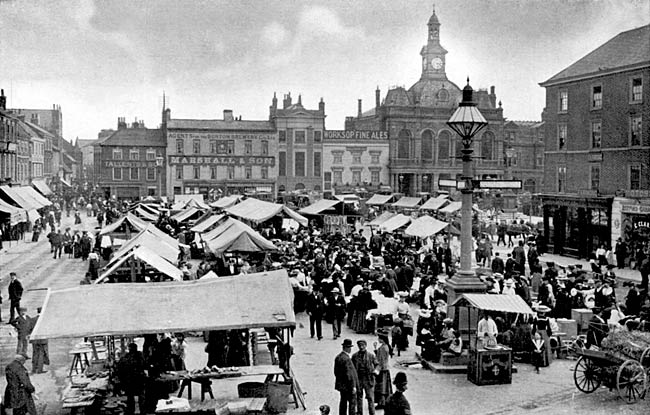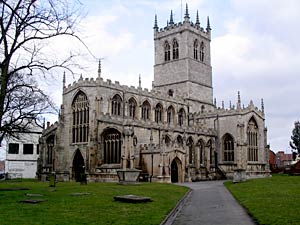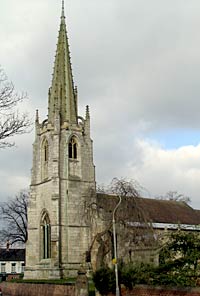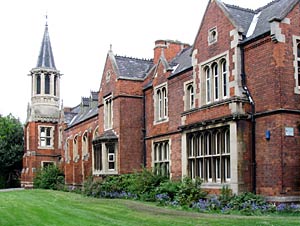< Previous | Contents | Next >
Where East Meets West

The market square in East Retford, c.1908.
RETFORD. East and West Retford are joined by an iron bridge over the River Idle, the old market town having gained much in importance when the Great North Road was diverted to it in 1766. There is an ever-burning light in the turret of a fine stone monument in the middle of the market square, set up in memory of the men who died for peace. On one side of the square is the 18th century town hall, proud of its historical portraits, and the fine regalia given for the most part in the 17th century. In front of it stands the Broad Stone, said to be perhaps the base of a cross which stood on a little hill called Dominie Cross, and believed to be one of four similar boundary stones in the neighbourhood.

St Swithun's church, East Retford, in 2006.
The glory of the town is the church of St Swithun near the marketplace, built like a cross with a central tower; the lovely exterior is adorned with battlements, lofty pinnacles, and panelled buttresses, and a splendid clerestory adds dignity and charm to the nave and chancel. The pinnacles are a study in themselves, for their lowest crockets make a fine gallery of about 254 heads of human folk and animals, with faces young and old, pleasant and grotesque. Other faces are on the hoods of the windows, and there are grotesque gargoyles here and there. In an outside recess is a modern figure, seated and crowned, said to represent Henry the Third.
Founded in 1258 by Roger, Archbishop of York, the church is for the most part 15th century in style, but is much rebuilt and restored. The tower collapsed in 1651, destroying most of the chancel, and both were made new. Two centuries later the chancel was enlarged, the north aisle rebuilt, and all the exterior re-faced.
The tower, 90 feet high, has its old base with four 13th century arches, and the nave arcades are chiefly 13th and 14th century. Very lovely are their capitals, carved with flowers and foliage—bluebells, thistles, berries, oak and acorns. One has vine and grapes growing from the mouth of a grotesque face, and two little figures are leaning on the branches. The middle pillar of two lovely bays dividing the north chapel has exquisite foliage.
Two chantries on the north side of the church are now a peace memorial chapel, and here is a charming little oak screen delicately carved with vines, trailing roses, and figures of Our Lord and angels. Leaves and berries enrich the dainty iron gates.
Among a few old glass fragments are three heads of bishops, and a curiosity in a window of the same transept is a penny, set in the glass. St Swithun (whose great statue is over the door inside the church) is a pleasing figure in a lancet. Two beautiful windows facing each other from the ends of the transepts are in memory of the Sherwood Rangers who fell in the Boer War and the Great War; one has ten fine saints, the other has Our Lord enthroned, saints singing, and figures representing Faith, Fortitude, Patience, and Obedience. A pleasant story we heard of two north-west windows, the gift of an old man who lived in an almshouse near the church, who loved nothing better than showing people round and with the money he received paid for these windows. He had little to call his, but he had a great heart.
Roses and quatrefoils and a happy little face peeping out of leaves are carved on the font, which has a pyramid cover. The roof beams of the nave and aisles rest on 25 stone angels, some with books and shields, others praying or playing instruments. Supporting the arch at the east end of the north aisle is a quaint jester, and a figure with a face half-veiled is holding up the corresponding arch of the south aisle.

West Retford church in 2006.
The beauty of West Retford's church of St Michael is outside, in its churchyard of lawn, and in its tower and spire. A "poem in stone" Pugin is said to have called this spire, and certainly both it and the tower are a high tribute to their 14th century builders. The tower (which becomes eight-sided at the top) has fine windows, and buttresses ending above the battlements in four lofty pinnacles. From these spring flying buttresses, and from the top of these four more slender pinnacles rise. About 120 graceful leaf sprays climb to the tip of the elegant spire.
A stone-roofed porch leads to the dim interior, with a medieval south arcade, a 19th century north aisle, an elaborately carved cover to the modern font, and an alabaster reredos showing the Ascension, its sculptured figures painted red, blue, white and gold. An engraved floorstone comes from 1485, and in a niche on one of the old pillars is a fine modern figure of St Oswald.
Near the church is Holy Trinity Hospital, founded in the 17th century for 16 poor bachelors or widowers, and made new in 1833. It is a charming block with a chapel, in a setting of lawn and shrubs and trimmed yew hedges.
South of the town is the modern church of St Alban, a fine, spacious place with the fresh bloom of youth. The walls inside are of cream Bath stone, the nave arcades have clustered pillars, and the chancel is entered by a wide, lofty arch. Lancet windows light the aisles; the fine east and west windows and those of the clerestory are in 15th century style. Very beautiful is the Kempe glass filling the east window, with Our Lord enthroned and figures of Gabriel, Mary, St Hugo, and St Cecilia in a company of nine saints. So high is the chancel that this great window is not hampered by the splendid oak reredos below it.

The former Retford Grammar School in 2008.
Near this church is King Edward's Grammar School, new-built in 1854. The school shared in Scott's immortal expedition to the South Pole, for it gave the sledge drawn by the pony Michael.
Here in 1683 was born Samuel Wright, the notable Nonconformist preacher of whom someone wrote:
Behold how papal Wright with lofty pride
Directs his haughty eye to either side,
Gives forth his doctrine with imperious nod,
And fraught with pride addresses e'en his God.
